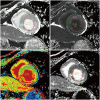Association Between Extracellular Volume Assessed by Cardiac MRI and New-Onset Atrial Fibrillation in Patients With ST-Segment Elevation Myocardial Infarction
- PMID: 40432261
- PMCID: PMC12123073
- DOI: 10.3348/kjr.2025.0070
Association Between Extracellular Volume Assessed by Cardiac MRI and New-Onset Atrial Fibrillation in Patients With ST-Segment Elevation Myocardial Infarction
Abstract
Objective: Although left ventricular (LV) fibrosis has been strongly linked to atrial fibrillation (AF), its relationship with new-onset AF (NOAF) following ST-segment elevation myocardial infarction (STEMI) remains unclear. This study aimed to investigate the association between different extracellular volume (ECV) measurements in the LV and NOAF during acute-phase STEMI.
Materials and methods: This retrospective study included 517 patients diagnosed with acute STEMI (440 males, 77 females; mean age, 57.2 ± 12.4 years). All patients underwent cardiac magnetic resonance (CMR) imaging with T1 mapping sequences during hospitalization. Blood samples were collected within 24 hours of the CMR examination. ECV was assessed in three regions of the left ventricle: the non-myocardial infarction region (NMI-ECV), the myocardial infarction region (MI-ECV), and the entire myocardium (integral ECV). Multi-variable logistic regression was used to evaluate the associations between these ECV parameters and NOAF. Receiver operating characteristic (ROC) analysis was performed to assess the predictive value of ECV measurements, both alone and in combination with two conventional risk factors-N-terminal pro-B-type natriuretic peptide and infarct-related artery (right coronary artery).
Results: During hospitalization, 40 (7.7%) patients developed NOAF. After adjusting for confounding factors, including left atrial strain, MI-ECV, NMI-ECV, and integral ECV were independently associated with NOAF. The area under the ROC curve for predicting NOAF was 0.702 (95% confidence interval: 0.615-0.789), 0.625 (0.531-0.719), and 0.712 (0.627-0.798) for MI-ECV, NMI-ECV, and integral ECV, respectively. The addition of integral ECV and MI-ECV to conventional factors significantly improved the predictive performance for NOAF.
Conclusion: ECV measured using CMR was independently and significantly associated with NOAF occurrence in acute-phase STEMI. Incorporating ECV into risk assessment models could significantly improve NOAF prediction.
Keywords: Atrial fibrillation; Cardiac magnetic resonance; Extracellular volume; Myocardial fibrosis; Myocardial infarction.
Copyright © 2025 The Korean Society of Radiology.
Conflict of interest statement
The authors have no potential conflicts of interest to disclose.
Figures




Similar articles
-
Predictive Value of the Naples Prognostic Score on New-Onset Atrial Fibrillation in ST-Segment Elevation Myocardial Infarction Following Primary Percutaneous Coronary Intervention.J Coll Physicians Surg Pak. 2025 Jul;35(7):819-824. doi: 10.29271/jcpsp.2025.07.819. J Coll Physicians Surg Pak. 2025. PMID: 40605202
-
CMR assessment of epicardial edipose tissue in relation to myocardial inflammation and fibrosis in patients with new-onset atrial arrhythmias after STEMI.BMC Cardiovasc Disord. 2025 Jan 20;25(1):34. doi: 10.1186/s12872-025-04486-1. BMC Cardiovasc Disord. 2025. PMID: 39833688 Free PMC article.
-
HATCH score associated with new-onset atrial fibrillation in patients with ST-segment elevation myocardial infarction.BMC Cardiovasc Disord. 2025 Jul 16;25(1):516. doi: 10.1186/s12872-025-04989-x. BMC Cardiovasc Disord. 2025. PMID: 40670941 Free PMC article.
-
Predictive value of uric acid/albumin ratio for the prediction of new-onset atrial fibrillation in patients with ST-Elevation myocardial infarction.Rev Invest Clin. 2022 May 2;74(3):156-164. doi: 10.24875/RIC.22000072. Rev Invest Clin. 2022. PMID: 35797660
-
Incidence and predictors of left ventricular thrombus by cardiovascular magnetic resonance in acute ST-segment elevation myocardial infarction treated by primary percutaneous coronary intervention: a meta-analysis.J Cardiovasc Magn Reson. 2018 Nov 8;20(1):72. doi: 10.1186/s12968-018-0494-3. J Cardiovasc Magn Reson. 2018. PMID: 30404623 Free PMC article. Review.
Cited by
-
Association of C₂HEST Score and New-Onset Atrial Fibrillation in Patients with Non-ST-Segment Elevation Myocardial Infarction.Med Sci Monit. 2025 Aug 13;31:e949555. doi: 10.12659/MSM.949555. Med Sci Monit. 2025. PMID: 40798858 Free PMC article.
References
-
- Ibanez B, James S, Agewall S, Antunes MJ, Bucciarelli-Ducci C, Bueno H, et al. 2017 ESC guidelines for the management of acute myocardial infarction in patients presenting with ST-segment elevation: the task force for the management of acute myocardial infarction in patients presenting with ST-segment elevation of the European Society of Cardiology (ESC) Eur Heart J. 2018;39:119–177. - PubMed
-
- Kinjo K, Sato H, Sato H, Ohnishi Y, Hishida E, Nakatani D, et al. Prognostic significance of atrial fibrillation/atrial flutter in patients with acute myocardial infarction treated with percutaneous coronary intervention. Am J Cardiol. 2003;92:1150–1154. - PubMed
-
- Wong CK, White HD, Wilcox RG, Criger DA, Califf RM, Topol EJ, et al. Significance of atrial fibrillation during acute myocardial infarction, and its current management: insights from the GUSTO-3 trial. Card Electrophysiol Rev. 2003;7:201–207. - PubMed
-
- Siu CW, Jim MH, Ho HH, Miu R, Lee SW, Lau CP, et al. Transient atrial fibrillation complicating acute inferior myocardial infarction: implications for future risk of ischemic stroke. Chest. 2007;132:44–49. - PubMed
MeSH terms
Grants and funding
LinkOut - more resources
Full Text Sources
Medical

